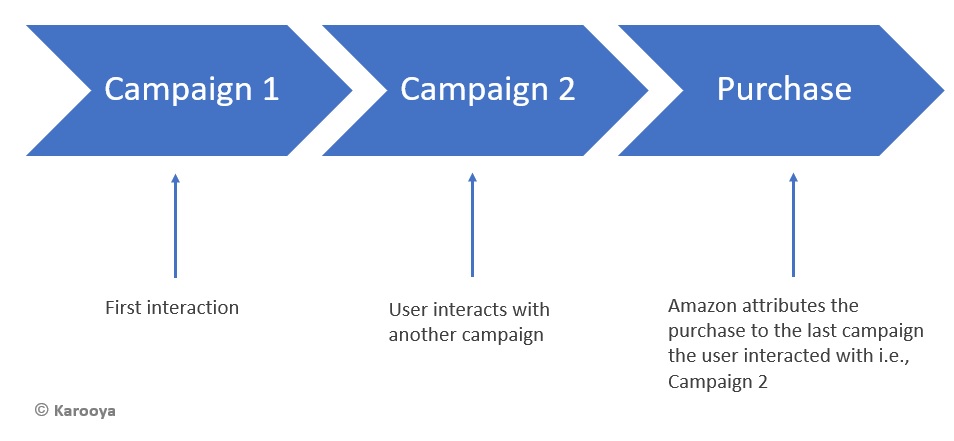Attribution credits sales to the ad campaign that led to the successful purchase of your product listed on Amazon. However, there is a time frame within which the sales need to take place after the click on your paid advertisement. Only then will it be attributed to the campaign, allowing you to assess its effectiveness.
What is Attribution Window?
Attribution Window is the time the customer takes to respond to an ad they interacted with (clicked). For example, if the attribution window is 7 days, then a customer who clicked on an ad and purchased within that 7 days window, the click would be attributed to the campaign which successfully led to the conversion.
Amazon Attribution Window
Similar to the definition above, the Amazon Attribution window is the time frame within which the sale can be attributed to the advertising campaign, after clicking on your ad. The attribution window differs for the campaign types. We will take you through them in this post. But before that lets understand more about the attribution window with two case scenarios:
- Any sales that happen outside of the attribution window aren’t credited to the ad campaign. What this means for a 7 day attribution window is that if the sale happens on the 8th day, then it will not be credited to ad campaign that induced that conversion.
- If a user clicked on an ad the first day and came back again the 6 the day and completed the purchase then the sale is attributed to the ad that was clicked on the first day. In this case, however, we would not know the time it took for the sales to close.
Amazon Attribution Model
Amazon uses the last touch attribution model. It means that the sales are attributed to the last campaign the user interacted with. For example, a user clicked on an ad from Campaign 1 and comes back again, and clicks on Campaign 2 which results in a sale. In such a case, sales will be attributed to Campaign 2.
Sponsored Product Attribution Window
The attribution window for this campaign type is different for vendors and sellers. The sales is reported on the date the ad was clicked.
- Vendors – The attribution window for Sponsored Campaign vendors is 14 days. It means that a product sale that happened within 14 days of when an ad was clicked gets captured. This will include sales of any product, advertised or not, offered by your brand.
- Sellers – The attribution window for Sponsored Campaign vendors is 7 days. This will include the sale of any product in your inventory, resulting from an ad clicked 7 days back.
Sponsored Brand Campaign
For both vendors and sellers, the attribution window is 14 days. The sales data includes sales of any product your brand offers that took place within the attribution window. Sales here is reported on the date the sales happened.
What effect attribution model and attribution window have on campaign evaluation?
We will take two scenarios to explain how the attribution window and the attribution model could impact advertiser decisions.
For example, a customer clicks on an ad on the 1st day that doesn’t translate into sales, he clicks on the ad again on the 3rd day and again on the 6th day. Finally, on the 7th day, he clicks on the ad, which results in a sale. The consumer has been on a multi-click trip, which cannot be determined because only the final click/touch is credited. You might assume that the sale has happened instantly, but you need to be coginizant of the fact that it hasn’t. As you analyze the sales generated by your advertising effort, keep this in mind.
Taking another example. A customer interacts with Ad1 on the first day and on the 6th day he clicks on Ad2 that results in the sales. In this case the sales get attributed to the last ad clicked, i.e, Ad2. Viewing the performance of your campaign, seeing the sales report, you might assume that Ad1 is underperforming whereas Ad2 is driving all the sales. However, as you can see, the Ad1 initiated the process, whereas Ad2 converted it. So, it might not be right to make decisions in haste by either discontinuing the Ad1 or overbidding on the Ad2.
Even though the sale is attributed in both circumstances, the customer journey cannot be followed. So while analyzing the campaign performance be mindful of all that.
If you promote your Amazon products on Google, then we have a product for that. Click here to learn more about it .
Related Links:






Stop the wasted ad spend. Get more conversions from the same ad budget.
Our customers save over $16 Million per year on Google and Amazon Ads.